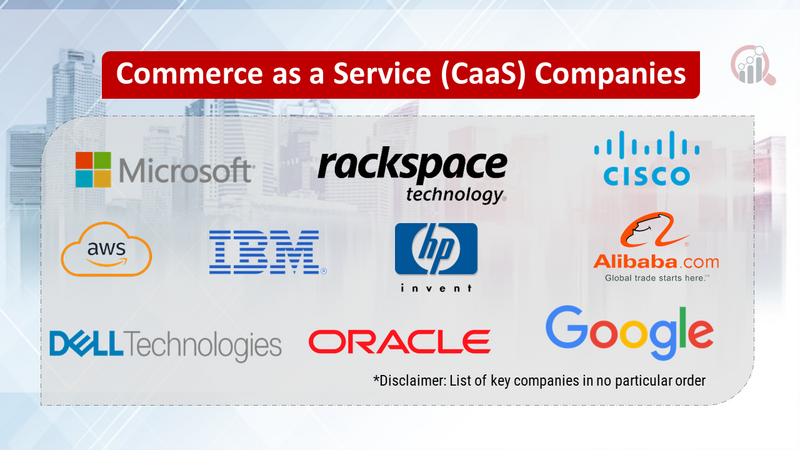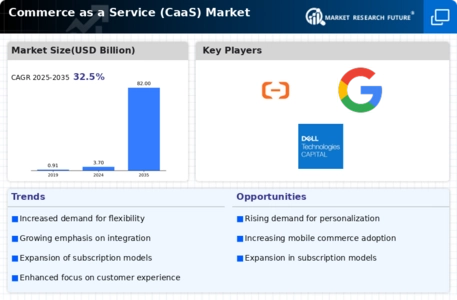Top Industry Leaders in the Commerce as a Service Market
 The CaaS Colosseum: Strategies and Players in the Booming E-commerce Arena
The CaaS Colosseum: Strategies and Players in the Booming E-commerce Arena
Commerce as a Service (CaaS) has emerged as a game-changer in the e-commerce world, providing businesses with an all-in-one platform to launch and manage their online stores. This market is experiencing explosive growth, fueled by the surge in online shopping and the increasing demand for agility and scalability. Let's explore the key players, their strategies, and the critical factors impacting their success in this gladiatorial arena of commerce.
Key Players:
- Microsoft Corporation
- Rackspace Hosting, Inc.
- Cisco System, Inc.
- Amazon Web Services, Inc.
- Google LLC
- Alibaba Cloud
- Dell Technologies Inc.
- Oracle Corporation
- Hewlett Packard Enterprise Development LP
- International Business Machine (IBM) Corporation
Strategies for Market Share:
-
Technology Innovation and Features: Offering cutting-edge features like AI-powered product recommendations, headless architecture for API integration, and omnichannel capabilities for seamless customer experiences is crucial. AWS's focus on intelligent search and Azure's integration with Dynamics 365 CRM exemplify this approach. -
Pricing and Deployment Models: Flexible pricing options like pay-as-you-go and hybrid deployment models (combining cloud and on-premises solutions) appeal to different customer segments. BigCommerce's tiered pricing and Shopware's self-hosted option illustrate this strategy. -
Ease of Use and User Experience: Providing intuitive interfaces, drag-and-drop functionalities, and comprehensive onboarding and support is essential for user adoption. Salesforce Commerce Cloud's visual editor and BigCommerce's extensive educational resources cater to this factor. -
Partnerships and Ecosystem Development: Building strong partnerships with payment gateways, shipping providers, and marketing platforms expands service offerings and attracts new customers. AWS's partnerships with Stripe and BigCommerce's app marketplace exemplify this strategy.
Factors for Market Share Analysis:
-
Revenue and Customer Base: These primary metrics offer insights into a player's financial strength and market presence. However, they don't always reflect innovation or niche strengths. -
Technology and Feature Set: The platform's functionalities, scalability, security, and integrations contribute significantly to its competitive edge. AWS's advanced analytics tools and Microsoft's strong CRM integration set them apart. -
Target Market and Industry Focus: Understanding the types of businesses a platform caters to (B2B, B2C, specific industries) and its regional reach offers insights into its market focus and potential growth areas. CloudCraze's B2B expertise and VTEX's Latin American presence exemplify this factor. -
Community and Ecosystem Strength: A strong developer community, robust app marketplace, and extensive partner network contribute to long-term success. Magento Open Source's vibrant community and BigCommerce's app marketplace with thousands of integrations illustrate this advantage.
New and Emerging Companies:
-
Snipcart: Focuses on providing a lightweight and mobile-first CaaS solution for small businesses and independent sellers. -
FastSpring: Specializes in global e-commerce solutions, helping businesses manage international payments, taxes, and compliance. -
Headless Platforms: Startups like Contentful and Prismic offer headless commerce platforms, separating the front-end user experience from the back-end commerce engine for maximum flexibility and customization.
Current Investment Trends:
-
Artificial Intelligence (AI): Integrating AI for personalized product recommendations, automated marketing campaigns, and fraud detection is a major focus area. AWS's AI-powered search and BigCommerce's AI-powered marketing tools exemplify this trend. -
Headless Commerce: Headless architectures are gaining traction for their flexibility and developer-friendly approach, attracting brands seeking unique shopping experiences. Contentful and Prismic are leading this charge. -
Subscription & Recurring Revenue Models: CaaS platforms are catering to the growing popularity of subscription-based businesses by offering subscription management functionalities and integrations with recurring billing providers. -
Social Commerce Integration: Seamless integration with social
-
Headless architecture taking center stage: Headless CaaS solutions are decoupling the front-end storefront from the back-end commerce engine, providing greater flexibility and control over the shopping experience. -
AI and machine learning for personalization: CaaS platforms are leveraging AI and machine learning to personalize product recommendations, promotions, and offers, improving customer engagement and conversion rates. -
Omnichannel becoming essential: CaaS solutions are integrating with physical stores and other touchpoints to provide a seamless omnichannel shopping experience for customers.









